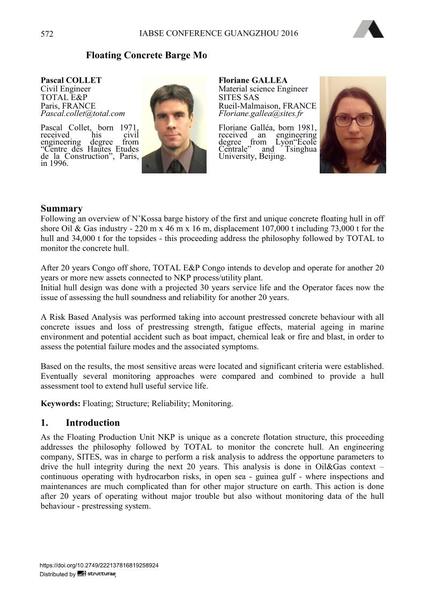Floating Concrete Barge Monitoring to Extend Service Life

|
|
|||||||||||
Bibliographic Details
| Author(s): |
Pascal Collet
Floriane Galléa |
||||
|---|---|---|---|---|---|
| Medium: | conference paper | ||||
| Language(s): | English | ||||
| Conference: | IABSE Conference: Bridges and Structures Sustainability - Seeking Intelligent Solutions, Guangzhou, China, 8-11 May 2016 | ||||
| Published in: | IABSE Conference, Guangzhou, China, 8 – 11 May 2016 | ||||
|
|||||
| Page(s): | 572-579 | ||||
| Total no. of pages: | 8 | ||||
| Year: | 2016 | ||||
| DOI: | 10.2749/222137816819258924 | ||||
| Abstract: |
Following an overview of N’Kossa barge history of the first and unique concrete floating hull in off shore Oil & Gas industry - 220 m x 46 m x 16 m, displacement 107,000 t including 73,000 t for the hull and 34,000 t for the topsides - this proceeding address the philosophy followed by TOTAL to monitor the concrete hull. After 20 years Congo off shore, TOTAL E&P Congo intends to develop and operate for another 20 years or more new assets connected to NKP process/utility plant. Initial hull design was done with a projected 30 years service life and the Operator faces now the issue of assessing the hull soundness and reliability for another 20 years. A Risk Based Analysis was performed taking into account prestressed concrete behaviour with all concrete issues and loss of prestressing strength, fatigue effects, material ageing in marine environment and potential accident such as boat impact, chemical leak or fire and blast, in order to assess the potential failure modes and the associated symptoms. Based on the results, the most sensitive areas were located and significant criteria were established. Eventually several monitoring approaches were compared and combined to provide a hull assessment tool to extend hull useful service life. |
||||
| Keywords: |
reliability structure floating monitoring
|
||||
